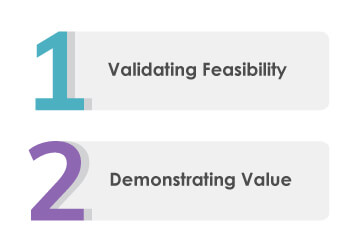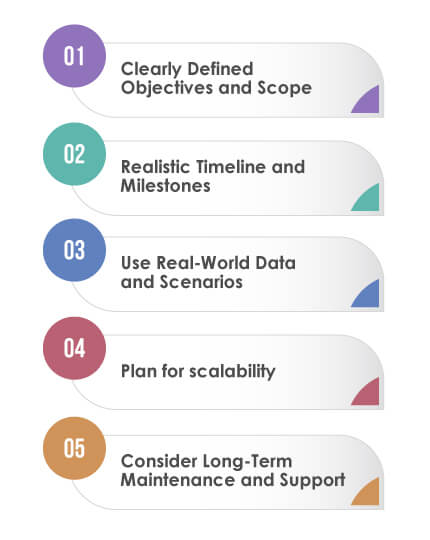Published: 06 Nov 2023
How to Implement Proof of Concept in Automation Testing
Table of Contents
- Why Implement a Proof of Concept in Automation Testing
- Planning and Preparation for PoC in Automation Testing
- Choosing the Right Tools and Technologies
- Best Practices and Tips for Successful PoC Implementation
- Conclusion
- How Can TestingXperts help you?
Automation Testing is leading modern software development, empowering teams to accelerate testing processes, enhance efficiency, and ensure impeccable software quality. It’s the art of leveraging technology to conduct tests, make data-driven decisions, and ultimately, deliver superior software products to the market.
Proof of Concept (PoC) stands as a guiding light of assurance and innovation. It’s the preliminary step, a glimpse into the future of automation testing, where ideas are validated, strategies are fine-tuned, and the potential of automation is vividly illustrated. PoC is not just a test; it’s an exploration, a prototype that showcases the transformative power of automation.
Why Implement a Proof of Concept in Automation Testing

Proof of Concept (PoC) plays a pivotal role in any innovative venture, serving as a crucial phase before full-scale implementation. Here’s why incorporating a Proof of Concept in automation testing can prove to be very important in the world of technological advancements:
Validating Feasibility
The first and foremost purpose of a Proof of Concept is to validate the feasibility and viability of an idea or concept. It provides a small-scale test environment to experiment with the concept in a controlled setting. By doing so, you can ascertain if the envisioned solution is technologically and practically possible. It’s akin to dipping a toe in the water before taking the plunge—minimizing risks and ensuring that resources are allocated to projects that hold promise and align with your business goals.
Demonstrating Value
Beyond feasibility, a PoC allows you to showcase the value proposition of your idea. It provides a tangible representation of what the product could achieve, allowing stakeholders to comprehend the potential benefits. This demonstration is instrumental in gaining buy-in from decision-makers, investors, and end-users. A well-executed PoC not only reveals the value of the solution but also instills confidence in the minds of stakeholders, fostering enthusiasm and support for the project. It’s the bridge that connects imagination to reality, ensuring that the value of an idea is clearly communicated and understood.
Planning and Preparation for PoC in Automation Testing

The success of a Proof of Concept (PoC) hinges on meticulous planning and thorough preparation. Let’s delve into the crucial aspects of planning and preparation for a PoC:
Defining Objectives
Before embarking on a PoC, it’s imperative to have clear and well-defined objectives. What do you aim to achieve with this PoC? These objectives should align with the broader goals of the project or initiative. Whether it’s testing a new technology, evaluating a specific feature, or proving a concept’s feasibility, outlining these objectives will provide a roadmap for the PoC. Clear objectives ensure that the effort is focused, and the outcomes are measured against predetermined criteria.
Resource Allocation
Resource allocation is a critical step in planning a successful PoC. This includes assigning the right people with the necessary skill sets to execute the PoC effectively. It also involves providing the required budget, tools, and time for the PoC to be conducted seamlessly. Adequate resourcing ensures that the team can work efficiently and achieve the set objectives within the defined timelines. It’s about putting the right pieces in place to make the PoC a meaningful and impactful exercise.
Infrastructure Requirements
Understanding and establishing the necessary infrastructure for the PoC is vital. This could encompass hardware, software, networking, and any other technological prerequisites. Ensure that the infrastructure mimics the intended real-world scenario as closely as possible to achieve accurate and relevant results. Additionally, consider scalability, flexibility, and security aspects while defining the infrastructure requirements. A well-planned infrastructure sets the stage for a smooth execution of the PoC, providing the foundation for thorough testing and validation. Here is the list of a few tools you can consider:
Choosing the Right Tools and Technologies

The choice of tools should align with your project’s goals, team expertise, and the technologies you are testing. The PoC phase is an excellent opportunity to evaluate and experiment with different tools to determine which ones best suit your long-term automation testing needs.
Selenium WebDriver (Script-Based)
Selenium WebDriver is a popular open-source tool for automating web applications. It provides a script-based approach to automation, allowing testers to write automation scripts in programming languages such as Java, Python, C#, and more. Selenium supports multiple web browsers and provides extensive flexibility for test automation.
Test Project (Low Code and No-code)
TestProject is a comprehensive test automation platform that offers both low-code and no-code capabilities. It provides a user-friendly, web-based interface for test creation, making it accessible to both technical and non-technical users. Testers can create automation tests visually with no coding or enhance them with scripting using Selenium and Appium.
Katalon Studio (Low-Code and Script-Based)
Katalon Studio is a test automation tool that combines low-code and script-based automation. It offers a user-friendly interface for creating test cases without extensive coding. While Katalon Studio simplifies automation for beginners with its low-code features, it also allows experienced testers to write scripts using Groovy or Java for more complex scenarios.
Tricentis Tosca (Script-Based and Low-Code)
Tricentis Tosca is an enterprise test automation platform that supports both script-based and low-code automation. It enables testers to create automation scripts in a variety of programming languages. Tosca also offers a low-code interface, making test case design more accessible to non-developers. It focuses on end-to-end test automation and integrates with various technologies and applications.
TestCraft (No-Code)
TestCraft is a no-code test automation platform designed for testers and non-technical users. It provides a visual, drag-and-drop interface for test creation, allowing users to create automation tests without writing any code. TestCraft specializes in web application automation and supports various browsers.
Best Practices and Tips for Successful PoC Implementation

Implementing a successful Proof of Concept (PoC) requires adherence to best practices and learning from experiences. Here are key considerations and lessons learned for a fruitful PoC implementation:
Key Considerations:
Clearly Defined Objectives and Scope:
Start by articulating clear objectives for your PoC. What do you aim to achieve, prove, or validate with this PoC? Without well-defined objectives, you risk losing focus and not effectively demonstrating the value of the proposed solution. Success criteria should be specific and measurable. For example, if you’re testing an automation tool, a success criterion might be a 20% reduction in test execution time.
Realistic Timeline and Milestones:
Assemble a team with a mix of skills and expertise relevant to the PoC. Include individuals who are well-versed in the subject matter and those who can provide fresh perspectives. Team members should have a good understanding of the project’s goals and be capable of working collaboratively. A diverse team can offer varied viewpoints and enhance problem-solving.
Use Real-World Data and Scenarios:
To make the PoC as realistic as possible, utilize actual data and real-world scenarios that mirror the environment where the solution will be implemented. Using synthetic or idealized data can skew results and lead to inaccurate conclusions. Real-world data and scenarios help in identifying potential issues, and any feedback derived is more applicable to practical situations.
Plan for scalability:
Even though the PoC is relatively small in scope, consider how the solution will scale if you decide to implement it on a broader scale. Evaluate the scalability of the solution in terms of performance, resource requirements, and ease of expansion. Assessing scalability during the PoC helps avoid future challenges when moving to a larger deployment.
Consider Long-Term Maintenance and Support:
While focusing on the PoC, don’t overlook the long-term maintenance and support aspects. Consider how easy it will be to maintain the solution, apply updates, and provide ongoing support. Factor in costs and resources needed for these activities when evaluating the viability of the solution.
Conclusion
Implementing a Proof of Concept (PoC) in automation testing is a strategic step that demands careful planning, precise execution, and a commitment to learning from the process. By following key considerations such as defining clear objectives, creating realistic timelines, involving diverse stakeholders, and employing a data-driven approach, organizations can ensure a solid foundation for their PoC.
Remember, a well-executed PoC not only validates the feasibility and value of an automation testing strategy but also provides valuable insights that steer decision-making and set the course for successful automation implementations. With a focused approach and a mindset of continuous improvement, PoCs in automation testing can drive innovation, elevate product quality, and contribute to achieving organizational excellence in the dynamic world of software development and testing.
How Can TestingXperts help you?

TestingXperts excels in assisting you throughout the implementation of a Proof of Concept (PoC) in Automation Testing. Our dedicated team collaborates closely with you to understand your specific testing needs and objectives. Leveraging our extensive expertise in automation testing and a wide range of tools, we craft a tailored PoC strategy aligned with your project requirements. We guide you in selecting the most suitable automation tools and technologies for your PoC, ensuring seamless integration with your existing systems. Throughout the PoC execution, we meticulously design and execute test cases, analyze results, and provide detailed reports with valuable insights. Our goal is to empower you to make informed decisions and pave the way for a successful transition from PoC to a robust, scalable automation strategy. With TestingXperts by your side, you’re poised to achieve efficiency, accuracy, and enhanced quality in your automation testing endeavors.